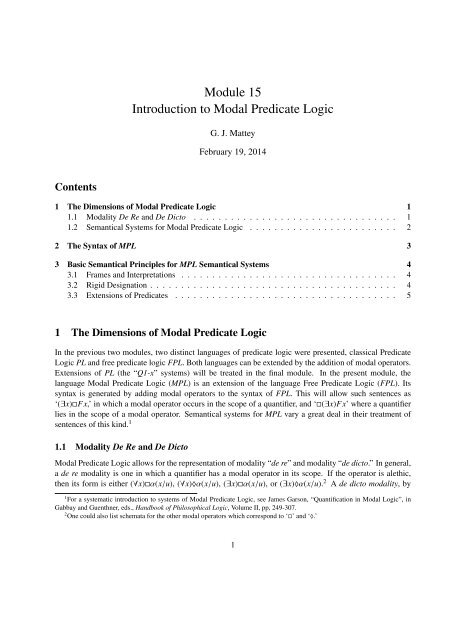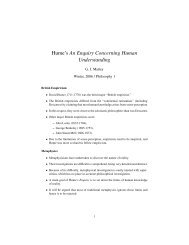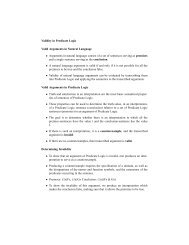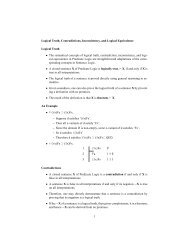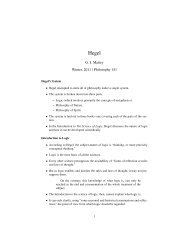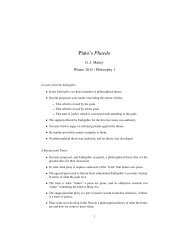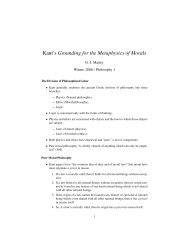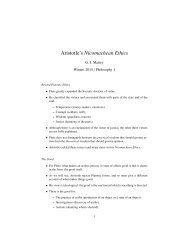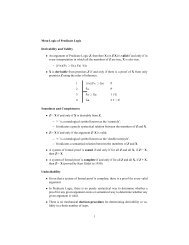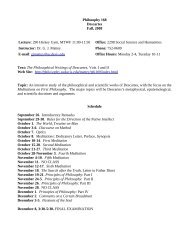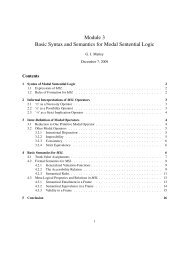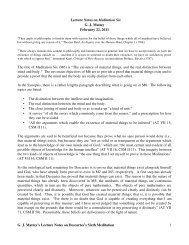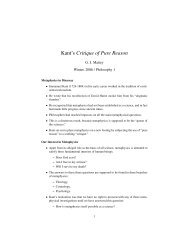Module 15 Introduction to Modal Predicate Logic
Module 15 Introduction to Modal Predicate Logic
Module 15 Introduction to Modal Predicate Logic
You also want an ePaper? Increase the reach of your titles
YUMPU automatically turns print PDFs into web optimized ePapers that Google loves.
<strong>Module</strong> <strong>15</strong><br />
<strong>Introduction</strong> <strong>to</strong> <strong>Modal</strong> <strong>Predicate</strong> <strong>Logic</strong><br />
G. J. Mattey<br />
February 19, 2014<br />
Contents<br />
1 The Dimensions of <strong>Modal</strong> <strong>Predicate</strong> <strong>Logic</strong> 1<br />
1.1 <strong>Modal</strong>ity De Re and De Dic<strong>to</strong> . . . . . . . . . . . . . . . . . . . . . . . . . . . . . . . . . 1<br />
1.2 Semantical Systems for <strong>Modal</strong> <strong>Predicate</strong> <strong>Logic</strong> . . . . . . . . . . . . . . . . . . . . . . . . 2<br />
2 The Syntax of MPL 3<br />
3 Basic Semantical Principles for MPL Semantical Systems 4<br />
3.1 Frames and Interpretations . . . . . . . . . . . . . . . . . . . . . . . . . . . . . . . . . . . 4<br />
3.2 Rigid Designation . . . . . . . . . . . . . . . . . . . . . . . . . . . . . . . . . . . . . . . . 4<br />
3.3 Extensions of <strong>Predicate</strong>s . . . . . . . . . . . . . . . . . . . . . . . . . . . . . . . . . . . . 5<br />
1 The Dimensions of <strong>Modal</strong> <strong>Predicate</strong> <strong>Logic</strong><br />
In the previous two modules, two distinct languages of predicate logic were presented, classical <strong>Predicate</strong><br />
<strong>Logic</strong> PL and free predicate logic FPL. Both languages can be extended by the addition of modal opera<strong>to</strong>rs.<br />
Extensions of PL (the “Q1-x” systems) will be treated in the final module. In the present module, the<br />
language <strong>Modal</strong> <strong>Predicate</strong> <strong>Logic</strong> (MPL) is an extension of the language Free <strong>Predicate</strong> <strong>Logic</strong> (FPL). Its<br />
syntax is generated by adding modal opera<strong>to</strong>rs <strong>to</strong> the syntax of FPL. This will allow such sentences as<br />
‘(∃x)□Fx,’ in which a modal opera<strong>to</strong>r occurs in the scope of a quantifier, and ‘□(∃x)Fx’ where a quantifier<br />
lies in the scope of a modal opera<strong>to</strong>r. Semantical systems for MPL vary a great deal in their treatment of<br />
sentences of this kind. 1<br />
1.1 <strong>Modal</strong>ity De Re and De Dic<strong>to</strong><br />
<strong>Modal</strong> <strong>Predicate</strong> <strong>Logic</strong> allows for the representation of modality “de re” and modality “de dic<strong>to</strong>.” In general,<br />
a de re modality is one in which a quantifier has a modal opera<strong>to</strong>r in its scope. If the opera<strong>to</strong>r is alethic,<br />
then its form is either (∀x)□α(x/u), (∀x)♦α(x/u), (∃x)□α(x/u), or (∃x)♦α(x/u). 2 A de dic<strong>to</strong> modality, by<br />
1 For a systematic introduction <strong>to</strong> systems of <strong>Modal</strong> <strong>Predicate</strong> <strong>Logic</strong>, see James Garson, “Quantification in <strong>Modal</strong> <strong>Logic</strong>”, in<br />
Gabbay and Guenthner, eds., Handbook of Philosophical <strong>Logic</strong>, Volume II, pp, 249-307.<br />
2 One could also list schemata for the other modal opera<strong>to</strong>rs which correspond <strong>to</strong> ‘□’ and ‘♦.’<br />
1
contrast, is one in which a quantifier is in the scope of a modal opera<strong>to</strong>r. For alethic modalities, its form is<br />
either □(∀x)α(x/u), ♦(∀x)α(x/u), □(∃x)α(x/u), or ♦(∃x)α(x/u).<br />
One kind of de re alethic modality predicates something necessarily of an object. Suppose we are talking<br />
about positive integers, and we want <strong>to</strong> say that there is a number that necessarily is odd, where the property<br />
of being odd is symbolized by the predicate letter ‘F.’ Then we can write: ‘(∃x)□Fx.’ There are de dic<strong>to</strong><br />
modalities by which one asserts that necessarily, there is something of which the predicate holds. In our<br />
example of positive integers, we might wish <strong>to</strong> say that necessarily, there is a number that is odd, which<br />
would be symbolized as ‘□(∃x)Fx.’ One of the interesting questions in the logic of quantifiers and modal<br />
opera<strong>to</strong>rs is whether modalities de re and de dic<strong>to</strong> imply one another. It will turn out that the choice of<br />
systems of MPL will bear directly on this question.<br />
In some applications, there are inferences that we would want <strong>to</strong> block. In doxastic logic, for example,<br />
we would not want <strong>to</strong> be able <strong>to</strong> conclude a de re modality from a de dic<strong>to</strong> modality. If someone believes<br />
that there exists a twenty-foot-tall human being, it ought not <strong>to</strong> follow that there is a twenty-foot-tall human<br />
being of whom the person believes <strong>to</strong> exist. So the choice of a system of MPL that handles these modalities<br />
properly is as important as the choice of a system of MSL that blocks the inference from one’s believing<br />
something <strong>to</strong> its being true.<br />
1.2 Semantical Systems for <strong>Modal</strong> <strong>Predicate</strong> <strong>Logic</strong><br />
There are many aspects of the semantics for <strong>Predicate</strong> <strong>Logic</strong> and for modal logic which allow for variation<br />
when they are combined. 3 In the first place, there are many systems of <strong>Modal</strong> Sentential <strong>Logic</strong> on which<br />
<strong>Modal</strong> <strong>Predicate</strong> <strong>Logic</strong> can be based. Secondly, the semantics for modal and predicate logics have complicating<br />
features not found in Sentential <strong>Logic</strong>. The two most important are these. <strong>Modal</strong> semantics has as<br />
its foundation frames containing sets of possible worlds at which sentences are assigned values by a valuation<br />
function. Semantics for <strong>Predicate</strong> <strong>Logic</strong> is based further on a non-empty domain of discourse, which<br />
contains the individuals which are the referents of names and serve as the values of variables.<br />
When the two are combined, there are several ways in which the possible worlds can be related <strong>to</strong> the<br />
domain of discourse. The simplest relation is that in which there is a single domain that applies across all<br />
possible worlds. This means that each world is populated by exactly the same objects. However, much of<br />
the appeal of modal logic lies in the idea that we can use it <strong>to</strong> represent states of affairs which are not actual.<br />
One way in which things might be different is that different objects exist. To capture this, one might wish <strong>to</strong><br />
allow that each possible world has its own domain of discourse. This complicates the semantics, as will be<br />
seen.<br />
Another issue is how <strong>to</strong> treat the assignment of constants <strong>to</strong> members of the domain of discourse (at a<br />
world, if the domain varies across worlds). Some semantical systems require that constants refer <strong>to</strong> exactly<br />
the same individuals, no matter what the world at which sentences containing them are evaluated. Or if<br />
domains vary, the constants designate the same thing in all those worlds at which the designee exists. 4<br />
Following Kripke we will call constants, and more generally terms, which designate the same member of<br />
the domain when they designate at all “rigid designa<strong>to</strong>rs.” Other systems might allow that a constant may<br />
refer <strong>to</strong> different individuals when sentences containing them are evaluated at different worlds. Yet another<br />
system (not treated here) banishes constants from the syntax al<strong>to</strong>gether. 5<br />
3 Some of these aspects will not be discussed here.<br />
4 See Saul A. Kripke, Naming and Necessity.<br />
5 This system is due <strong>to</strong> Saul A. Kripke, “Semantical Considerations on <strong>Modal</strong> <strong>Logic</strong>,” Acta Philosophica Fennica 16 (1963),<br />
83-94).<br />
2
If domains of discourse are allowed <strong>to</strong> vary from world <strong>to</strong> world, then even if constants are rigid designa<strong>to</strong>rs,<br />
the domain at a world might not contain the object <strong>to</strong> which it refers. In that case, given the<br />
semantics for PLI, some sentences will be lacking in truth-values. This forces a change in the semantics, in<br />
that “truth-value gaps” must be incorporated in<strong>to</strong> the semantical rules.<br />
If the semantics is going <strong>to</strong> be changed, we might just as well base the modal system on free logic,<br />
which allows for constants that do not refer <strong>to</strong> any individual in the relevant domain of discourse. This<br />
alternative is a natural fit for modal logic, because it provides a way of reasoning about non-existent but<br />
possible individuals.<br />
In the next three modules, we will investigate three families of systems of <strong>Modal</strong> <strong>Predicate</strong> <strong>Logic</strong> with<br />
identity. The first will be the weakest of such systems, the Q1R systems, which are based on free logic.<br />
These systems are the most flexible in representing what exists at possible worlds, but they do not have<br />
very strong consequences within the logic itself. We will next take a look at the strongest, and conceptually<br />
simplest systems, the Q1 systems, due <strong>to</strong> Kripke. In these systems, classical predicate logic remains intact,<br />
and some quite controversial consequences concerning de re and de dic<strong>to</strong> modalities hold in them. Finally,<br />
we will look at a family of systems that allows world-relative domains, but based on an underlying system<br />
of <strong>Predicate</strong> <strong>Logic</strong> which is not “free.” The QPL systems allow truth-value gaps and are strong enough <strong>to</strong><br />
forge some interesting connections betwen quantifiers and modal opera<strong>to</strong>rs in these systems.<br />
2 The Syntax of MPL<br />
Before we look at the specific character of the three systems of modal predicate logic, we will lay down the<br />
syntax which is common <strong>to</strong> them all.<br />
The syntax of MPL is built upon that of MSL and PL. Sentence letters, falsum, SL opera<strong>to</strong>rs, and modal<br />
opera<strong>to</strong>rs are carried over from MSL <strong>to</strong> MPL. <strong>Predicate</strong> <strong>Logic</strong> adds constants, variables, predicate letters,<br />
the identity predicate symbol, and quantifiers. These expressions were defined in the module on non-modal<br />
predicate logic. We can combine the formation rules for <strong>Modal</strong> Sentential <strong>Logic</strong> and <strong>Predicate</strong> <strong>Logic</strong> <strong>to</strong> get<br />
the following more comprehensive definition of a sentence of <strong>Modal</strong> <strong>Predicate</strong> <strong>Logic</strong>.<br />
1. All sentence letters are sentences of MPL.<br />
2. ‘⊥’ is a sentence of MPL.<br />
3. If t is a term of MPL, then ‘E 1 t’ is a sentence of MPL.<br />
4. If P n is a predicate of MPL and t 1 , . . . , t n are terms of MPL, then P n t 1 , . . . , t n is a sentence of MPL<br />
5. If t 1 and t 2 are terms of MPL, then t 1 = t 2 is a sentence of MPL.<br />
6. If α is a sentence of MPL, then ∼α is a sentence of MPL.<br />
7. If α and β are sentences of MPL, then (α ∧ β) is a sentence of MPL.<br />
8. If α and β are sentences of MPL, then (α ∨ β) is a sentence of MPL.<br />
9. If α and β are sentences of MPL, then (α ⊃ β) is a sentence of MPL.<br />
10. If α and β are sentences of MPL, then (α ≡ β) is a sentence of MPL.<br />
11. If α(u) is a sentence of MPL and u is free for x in α(u), then (∀x)α(x/u) is a sentence of MPL.<br />
3
12. If α(u) is a sentence of MPL and u is free for x in α(u), then (∃x)α(x/u) is a sentence of MPL.<br />
13. If α is a sentence of MPL, then □α is a sentence of MPL.<br />
14. If α is a sentence of MPL, then ♦α is a sentence of MPL.<br />
<strong>15</strong>. If α and β are sentences of MPL, then α β is a sentence of MPL.<br />
16. Nothing else is a sentence of MPL.<br />
3 Basic Semantical Principles for MPL Semantical Systems<br />
We will here give some semantical definitions and stipulations that are common <strong>to</strong> all the systems we will<br />
study.<br />
3.1 Frames and Interpretations<br />
As with modal sentential logic, the basic semantical structures will be called frames. A frame for <strong>Modal</strong><br />
<strong>Predicate</strong> <strong>Logic</strong> results from adding <strong>to</strong> a <strong>Modal</strong> Sentential <strong>Logic</strong> frame 〈W,R〉 (at least) a domain of discourse<br />
D. 6 So a base MPL frame Fr = 〈W,R,D〉. The only restriction on D is that it be non-empty. (The<br />
set of possible worlds W must also have at least one member.) It may contain infinitely many members.<br />
The domain of discourse consists of the “possible objects” <strong>to</strong> which we can refer using terms of MPL. An<br />
interpretation based on Fr just is Fr with the addition of a valuation function v I . So a base interpretation I<br />
is (at least) an ordered four-tuple 〈W,R,D,v〉. 7<br />
The valuation function v I works just as in the MSL semantics for sentence letters, truth-functional sentences,<br />
and modal sentences. That is, it is a two-place function from a pair consisting of a sentence and a<br />
world <strong>to</strong> the truth-values T and F. For syntax proper <strong>to</strong> PL, the first argument of the function is either a constant,<br />
a parameter, a predicate, or a PL sentence which is not a sentence of SL. Thus, the valuation function<br />
for MPL is an augmented version of the valuation function for PL. For example, the valuation function v I<br />
might return a truth-value T for the sentence ‘□Fa’ at a world w: v I (□Fa,w) = T.<br />
3.2 Rigid Designation<br />
Since in the semantics for MPL we evaluate sentences at worlds, we must deal with the question, raised<br />
above, as <strong>to</strong> the values assigned by the valuation function <strong>to</strong> constants and parameters. In non-modal <strong>Predicate</strong><br />
<strong>Logic</strong>, there is only one domain whose members serve as values of terms for a given interpretation.<br />
But now the option is open <strong>to</strong> allow the assignment of a term at one world <strong>to</strong> differ from its assignment at<br />
another world.<br />
At this point, we will adopt a procedure that will hold for all of the semantical systems <strong>to</strong> be studied.<br />
We shall require that all terms be assigned the same object at all worlds. That is, we will treat terms (both<br />
constants and parameters) as rigid designa<strong>to</strong>rs. For any two worlds, the term has the same value at both<br />
worlds.<br />
Rigid Designation<br />
(Πw i )(Πw j )((w i ∈ W ∧ w j ∈ W) → v I (t, w i ) = v I (t, w j ))<br />
6 In some systems, a frame contains an additional element: a function q which assigns <strong>to</strong> each world its own domain.<br />
7 As noted above, in some systems an additional element is added <strong>to</strong> each frame.<br />
4
The assumption of rigid designation greatly simplifies the semantics as well as facilitating completeness<br />
results. 8 But the simplification comes at a price. We cannot use constants <strong>to</strong> stand for definite descriptions,<br />
since expressions like “the first human <strong>to</strong> walk on the moon” would be expected <strong>to</strong> have different values at<br />
different possible worlds. Thus, constants represent only proper names, such as ‘Neil Armstrong.’<br />
3.3 Extensions of <strong>Predicate</strong>s<br />
As with non-modal PL, the extension of an n-place predicate P is a set of ordered n-tuples taken from D.<br />
Because the valuation function takes a world as an argument, we can allow that the extension of a predicate<br />
varies from world <strong>to</strong> world unlike in PLI, where it is fixed. Supposing that D w is the domain at a given world<br />
w:<br />
Extension of <strong>Predicate</strong>s<br />
v I (P n , w) ⊆ D wn .<br />
If the extensions of predicates were not allowed <strong>to</strong> vary from world <strong>to</strong> world, the resulting semantical system<br />
would be of no interest from the standpoint of modality. We would then not be able <strong>to</strong> distinguish between<br />
worlds at which something has a property or stands in a relation and a world at which it does not.<br />
With these basic semantical notions in mind, we now move <strong>to</strong> the presentation of the systems which<br />
employ them.<br />
8 See Garson, pp. 261-265.<br />
5


